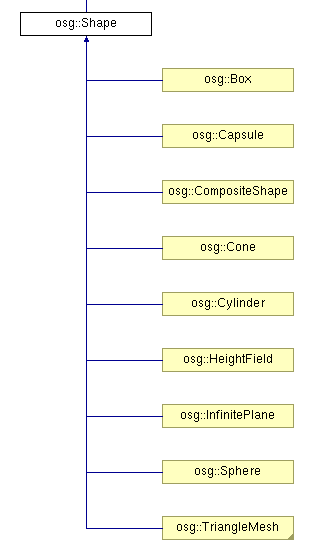本例示范了osg中Shape ---- 基本几何元素的绘制过程。参照osg官方文档,Shape 类包含以下子类:

在示例程序中,函数createShapes函数用于生成需要绘制的几何形状。
1 osg::Geode* createShapes(osg::ArgumentParser& arguments) 2 { 3 osg::Geode* geode = new osg::Geode(); 4 5 6 // --------------------------------------- 7 // Set up a StateSet to texture the objects 8 // --------------------------------------- 9 osg::StateSet* stateset = new osg::StateSet(); 10 //设置材质图片 11 osg::ref_ptr<osg::Image> image = osgDB::readRefImageFile( "Images/lz.rgb" ); 12 if (image) 13 { 14 osg::Texture2D* texture = new osg::Texture2D; 15 texture->setImage(image); 16 texture->setFilter(osg::Texture::MIN_FILTER, osg::Texture::LINEAR); 17 stateset->setTextureAttributeAndModes(0,texture, osg::StateAttribute::ON); 18 } 19 20 stateset->setMode(GL_LIGHTING, osg::StateAttribute::ON); 21 22 geode->setStateSet( stateset ); 23 24 25 float radius = 0.8f; 26 float height = 1.0f; 27 28 osg::TessellationHints* hints = new osg::TessellationHints; 29 hints->setDetailRatio(0.5f); 30 //建立各种几何实体 31 geode->addDrawable(new osg::ShapeDrawable(new osg::Sphere(osg::Vec3(0.0f,0.0f,0.0f),radius),hints)); 32 geode->addDrawable(new osg::ShapeDrawable(new osg::Box(osg::Vec3(2.0f,0.0f,0.0f),2*radius),hints)); 33 geode->addDrawable(new osg::ShapeDrawable(new osg::Cone(osg::Vec3(4.0f,0.0f,0.0f),radius,height),hints)); 34 geode->addDrawable(new osg::ShapeDrawable(new osg::Cylinder(osg::Vec3(6.0f,0.0f,0.0f),radius,height),hints)); 35 geode->addDrawable(new osg::ShapeDrawable(new osg::Capsule(osg::Vec3(8.0f,0.0f,0.0f),radius,height),hints)); 36 //用于控制平面的高程起伏 37 osg::HeightField* grid = new osg::HeightField; 38 if (arguments.read("--large")) //大范围 39 { 40 unsigned int numX = 512; 41 unsigned int numY = 512; 42 double sizeX = 10.0; 43 double sizeY = 10.0; 44 grid->allocate(numX,numY); 45 grid->setXInterval(sizeX/float(numX)); 46 grid->setYInterval(sizeY/float(numY)); 47 48 for(unsigned int r=0;r<numY;++r) 49 { 50 for(unsigned int c=0;c<numX;++c) 51 { 52 double rx = double(c)/double(numX-1); 53 double ry = double(r)/double(numY-1); 54 55 grid->setHeight(c, r, 2.0*sin(rx*ry*4.0*osg::PI)); 56 } 57 } 58 } 59 else //小范围 60 { 61 grid->allocate(38,39); 62 grid->setXInterval(0.28f); 63 grid->setYInterval(0.28f); 64 65 for(unsigned int r=0;r<39;++r) 66 { 67 for(unsigned int c=0;c<38;++c) 68 { 69 grid->setHeight(c,r,vertex[r+c*39][2]); 70 } 71 } 72 } 73 74 geode->addDrawable(new osg::ShapeDrawable(grid)); 75 76 return geode; 77 }
在以上代码中,首先建立了几何节点Geode,加载纹理图像,并将其设置为节点的材质。
之后向节点中加入各种Shape模型,设置它们的集合参数。之后建立了高程域模型osg::HeightField* grid,根据运行程序时提供的命令行参数,设置其为不同的点密度。若运行命令中提供有--large选项,则建立高密度高程集,两层for循环中嵌套的语句,即为计算高程网格中各点的高程值方程。对于large情形,其在点(x,y)处的高程值为2*sin(x*y*4π)。而在普通情况下,点的高程值取决与vertex向量的第三个分量,因为在文件的开始,包含了地形坐标数据:
#include "../osghangglide/terrain_coords.h"
最后,将定义的地形平面添加到节点中去。
在主函数中,调用上面定义的createShapes函数,在进行一些其他准备工作即可:
int main(int argc, char **argv) { osg::ArgumentParser arguments(&argc,argv); // construct the viewer. osgViewer::Viewer viewer(arguments); // add model to viewer. viewer.setSceneData( createShapes(arguments) ); // add the state manipulator viewer.addEventHandler( new osgGA::StateSetManipulator(viewer.getCamera()->getOrCreateStateSet()) ); return viewer.run(); }
按不同模式运行程序,得到不同的效果:
--large模式:

正常模式:

由此程序受到启发,可利用osg高程域,建立DEM(数字高程模型)浏览或仿真、编辑工具,达到学以致用的目的。
Enjoy!